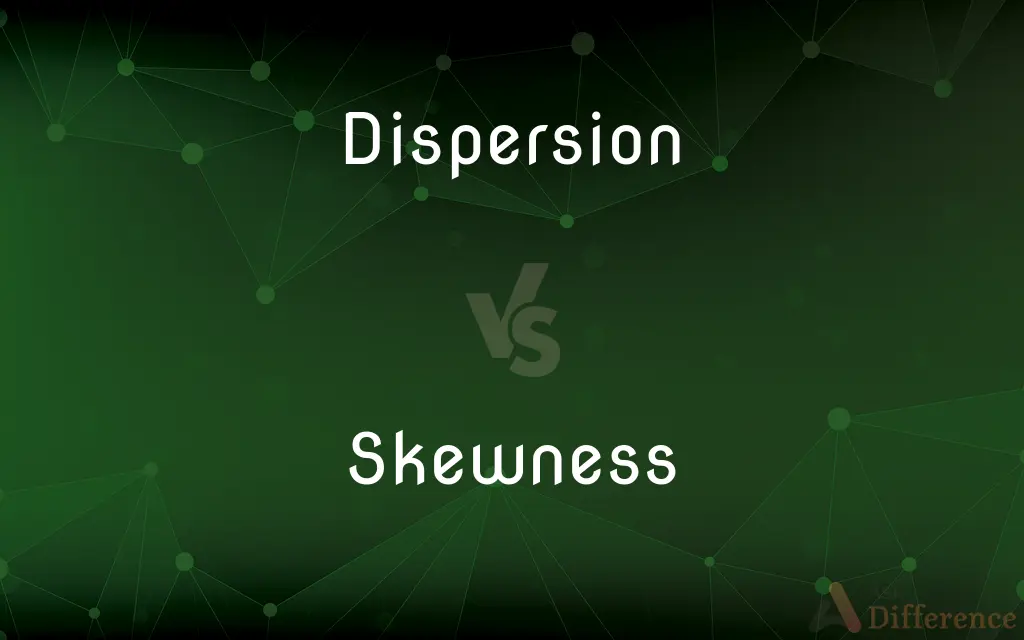Dispersion vs. Skewness — What's the Difference?
By Tayyaba Rehman & Fiza Rafique — Updated on May 9, 2024
Dispersion measures the spread of data points in a dataset, while skewness indicates the asymmetry or deviation from a normal distribution.

Difference Between Dispersion and Skewness
Table of Contents
ADVERTISEMENT
Key Differences
Dispersion is a statistical term that quantifies the extent to which data points in a dataset are spread out. On the other hand, skewness measures the degree to which these data points deviate from a symmetrical distribution, focusing on the direction and shape of the data’s distribution.
Common measures of dispersion include variance, standard deviation, and range, which provide insights into the variability within a dataset. Whereas skewness is specifically assessed through skewness coefficients, indicating whether the data tail is heavier on the right or left side of the distribution.
Dispersion does not indicate the direction of spread but only the extent; it is neutral regarding the data’s symmetry or asymmetry. Meanwhile, skewness is directionally sensitive, distinguishing between right (positive) skew and left (negative) skew based on the distribution’s tail.
In applications, understanding dispersion helps in assessing risk and variability, important in fields like finance and quality control. On the other hand, skewness is crucial in statistical modeling and data analysis, especially when making assumptions about the underlying distribution for advanced statistical tests.
While both concepts describe characteristics of distribution, dispersion is generally used to summarize data sets with simple numerical values. In contrast, skewness provides a more nuanced picture of the data’s distribution shape, influencing hypotheses in statistical tests.
ADVERTISEMENT
Comparison Chart
Definition
Measure of how spread out the data points are.
Measure of how asymmetrical the data distribution is.
Key Metrics
Variance, Standard Deviation, Range
Skewness Coefficient
Indicates
Degree of spread
Direction and degree of asymmetry
Sensitivity to Distribution
Neutral to the shape of distribution
Sensitive to the shape of distribution
Application Example
Assessing volatility in financial markets
Modeling data not following a normal distribution
Compare with Definitions
Dispersion
Variance, a measure of dispersion, is the average of the squared differences from the mean.
Higher variance in a manufacturing process can indicate greater inconsistency in product quality.
Skewness
Skewness can be positive or negative, reflecting the tail heaviness of the distribution.
Negative skewness in temperature data could indicate more extremely cold days.
Dispersion
Dispersion helps in understanding the reliability and consistency of data sets.
Low dispersion in product dimensions highlights consistent manufacturing.
Skewness
Skewness affects statistical analyses and outcomes.
In financial modeling, skewness is used to gauge the potential for extreme outcomes.
Dispersion
Dispersion is quantified through metrics such as the range and standard deviation.
A larger range in employee salaries suggests high dispersion in income.
Skewness
Understanding skewness is essential for correct data interpretation and analysis.
Skewness in customer satisfaction ratings can influence business strategies.
Dispersion
Dispersion is crucial for statistical reliability and decision-making.
Financial analysts use dispersion to evaluate investment risk.
Skewness
A measure of the asymmetry in a distribution of data.
Positive skewness in wealth distribution shows more people with below-average wealth.
Dispersion
The degree to which individual data points are spread out around a central value.
In a set of test scores, high dispersion indicates varied performance among students.
Skewness
It is critical in determining the fit for normal distribution assumptions in data.
Skewness in test results may affect the validity of using parametric statistical tests.
Dispersion
The action or process of distributing things or people over a wide area
Some seeds rely on birds for dispersion
Skewness
In probability theory and statistics, skewness is a measure of the asymmetry of the probability distribution of a real-valued random variable about its mean. The skewness value can be positive, zero, negative, or undefined.
Dispersion
The separation of white light into colours or of any radiation according to wavelength.
Skewness
To turn or place at an angle
Skew the cutting edge of a plane.
Dispersion
The extent to which values of a variable differ from a fixed value such as the mean.
Skewness
To give a bias to; distort
The use of a limited sample skewed the findings of the study.
Dispersion
The act or process of dispersing.
Skewness
To take an oblique course or direction.
Dispersion
The state of being dispersed.
Skewness
To look obliquely or sideways.
Dispersion
Dispersion The Diaspora of the Jews.
Skewness
To display a statistical tendency toward
A television program that skews toward teenagers.
Dispersion
(Statistics) The degree of scatter of data, usually about an average value, such as the median.
Skewness
Placed or turned to one side; asymmetric.
Dispersion
Separation of a complex wave into its component parts according to a given characteristic, such as frequency or wavelength.
Skewness
Distorted or biased in meaning or effect.
Dispersion
Separation of visible light into colors by refraction or diffraction.
Skewness
Having a part that diverges, as in gearing.
Dispersion
(Chemistry) See disperse system.
Skewness
(Mathematics) Neither parallel nor intersecting. Used of straight lines in space.
Dispersion
The state of being dispersed; dispersedness.
Skewness
(Statistics) Not symmetrical about the mean. Used of distributions.
Dispersion
A process of dispersing.
Skewness
An oblique or slanting movement, position, or direction.
Dispersion
The degree of scatter of data.
Skewness
The property of being skew.
Dispersion
(optics) The separation of visible light by refraction or diffraction.
Skewness
(statistics) A measure of the asymmetry of the probability distribution of a real-valued random variable; is the third standardized moment, defined as where is the third moment about the mean and is the standard deviation.
Dispersion
(medicine) The removal of inflammation.
Skewness
An oblique or slanting asymmetry
Dispersion
The act or process of scattering or dispersing, or the state of being scattered or separated; as, the Jews in their dispersion retained their rites and ceremonies; a great dispersion of the human family took place at the building of Babel.
The days of your slaughter and of your dispersions are accomplished.
Dispersion
The separation of light into its different colored rays, arising from their different refrangibilities.
Dispersion
Spreading widely or driving off
Dispersion
The spatial property of being scattered about over an area or volume
Dispersion
The act of dispersing or diffusing something;
The dispersion of the troops
The diffusion of knowledge
Common Curiosities
What is the primary difference between dispersion and skewness?
Dispersion measures the spread of data points, while skewness measures the asymmetry in their distribution.
Why is understanding dispersion important in statistics?
Understanding dispersion is crucial for assessing data variability, which affects decision-making and risk assessment.
How does positive skew affect statistical analysis?
Positive skew can lead to overestimation of mean values and affects the assumptions of many statistical tests.
What is meant by left skew or negative skewness?
Left skew, or negative skewness, occurs when more data points are concentrated on the right of the mean, with a long tail to the left.
How does high dispersion affect data interpretation?
High dispersion indicates a wide spread of data points, which can imply greater variability and potential outliers affecting overall analysis.
What are practical examples of dispersion in real life?
Variability in product quality, income levels, or investment returns are all real-life examples of dispersion.
What tools are used to measure skewness and dispersion?
Statistical software and tools like Excel provide functions to calculate skewness and dispersion measures like standard deviation.
Can skewness be zero?
Yes, skewness can be zero when the data is perfectly symmetrical.
What role does standard deviation play in measuring dispersion?
Standard deviation provides a measure of the average distance of data points from the mean, reflecting dispersion.
Can a dataset be skewed and still have low dispersion?
Yes, a dataset can be skewed with low dispersion if the majority of data points are close to the mean but with a long tail on one side.
Is skewness a measure of central tendency?
No, skewness is not a measure of central tendency but rather a measure of distribution symmetry.
How does skewness influence the choice of statistical tests?
Skewness can affect the validity of parametric tests, which often assume normal distribution, influencing the choice of appropriate statistical methods.
Does high skewness affect model performance?
Yes, high skewness can affect the performance of statistical models, especially those assuming data normality.
Can both dispersion and skewness be derived from the same dataset?
Yes, both dispersion and skewness can be computed from the same dataset to provide a comprehensive understanding of its statistical properties.
Why is skewness important in finance?
Skewness indicates the potential for extreme results in financial returns, essential for risk management.
Share Your Discovery

Previous Comparison
Brotha vs. Brother
Next Comparison
Beaver vs. GroundhogAuthor Spotlight
Written by
Tayyaba RehmanTayyaba Rehman is a distinguished writer, currently serving as a primary contributor to askdifference.com. As a researcher in semantics and etymology, Tayyaba's passion for the complexity of languages and their distinctions has found a perfect home on the platform. Tayyaba delves into the intricacies of language, distinguishing between commonly confused words and phrases, thereby providing clarity for readers worldwide.
Co-written by
Fiza RafiqueFiza Rafique is a skilled content writer at AskDifference.com, where she meticulously refines and enhances written pieces. Drawing from her vast editorial expertise, Fiza ensures clarity, accuracy, and precision in every article. Passionate about language, she continually seeks to elevate the quality of content for readers worldwide.













































